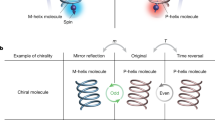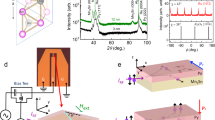Abstract
Chirality is a fascinating phenomenon that can manifest itself in subtle ways, for example in biochemistry (in the observed single-handedness of biomolecules1) and in particle physics (in the charge-parity violation of electroweak interactions2). In condensed matter, magnetic materials can also display single-handed, or homochiral, spin structures. This may be caused by the Dzyaloshinskii–Moriya interaction, which arises from spin–orbit scattering of electrons in an inversion-asymmetric crystal field3,4. This effect is typically irrelevant in bulk metals as their crystals are inversion symmetric. However, low-dimensional systems lack structural inversion symmetry, so that homochiral spin structures may occur5. Here we report the observation of magnetic order of a specific chirality in a single atomic layer of manganese on a tungsten (110) substrate. Spin-polarized scanning tunnelling microscopy reveals that adjacent spins are not perfectly antiferromagnetic but slightly canted, resulting in a spin spiral structure with a period of about 12 nm. We show by quantitative theory that this chiral order is caused by the Dzyaloshinskii–Moriya interaction and leads to a left-rotating spin cycloid. Our findings confirm the significance of this interaction for magnets in reduced dimensions. Chirality in nanoscale magnets may play a crucial role in spintronic devices, where the spin rather than the charge of an electron is used for data transmission and manipulation. For instance, a spin-polarized current flowing through chiral magnetic structures will exert a spin-torque on the magnetic structure6,7, causing a variety of excitations or manipulations of the magnetization8,9 and giving rise to microwave emission, magnetization switching, or magnetic motors.
This is a preview of subscription content, access via your institution
Access options
Subscribe to this journal
Receive 51 print issues and online access
$199.00 per year
only $3.90 per issue
Buy this article
- Purchase on Springer Link
- Instant access to full article PDF
Prices may be subject to local taxes which are calculated during checkout




Similar content being viewed by others
References
Siegel, J. S. Single-handed cooperation. Nature 409, 777–778 (2001)
Ellis, J. Antimatter matters. Nature 424, 631–634 (2003)
Dzialoshinskii, I. E. Thermodynamic theory of ”weak” ferromagnetism in antiferromagnetic substances. Sov. Phys. JETP 5, 1259–1262 (1957)
Moriya, T. Anisotropic superexchange interaction and weak ferromagnetism. Phys. Rev. 120, 91–98 (1960)
Fert, A. Magnetic and transport properties of metallic multilayers. Mater. Sci. Forum 59&60, 439–443 (1990)
Berger, L. Emission of spin waves by a magnetic multilayer traversed by a current. Phys. Rev. B 54, 9353–9358 (1996)
Slonczewski, J. C. Current-driven excitation of magnetic multilayers. J. Magn. Magn. Mater. 199, L1–L11 (1996)
Kiselev, S. I. et al. Microwave oscillations of a nanomagnet driven by a spin-polarized current. Nature 425, 380–383 (2003)
Krivorotov, I. N. et al. Time-domain measurements of nanomagnet dynamics driven by spin-transfer torques. Science 307, 228–231 (2005)
Heisenberg, W. Zur Theorie des Ferromagnetismus. Z. Phys. 49, 619–636 (1928)
Rößler, U. K., Bogdanov, A. N. & Pfleiderer, C. Spontaneous skyrmion ground states in magnetic metals. Nature 442, 797–801 (2006)
Uchida, M., Onose, Y., Matsui, Y. & Tokura, Y. Real-space observation of helical spin order. Science 311, 359–361 (2006)
Heinze, S. et al. Real-space imaging of two-dimensional antiferromagnetism on the atomic scale. Science 288, 1805–1808 (2000)
Bode, M. et al. Magnetization-direction–dependent local electronic structure probed by scanning tunneling spectroscopy. Phys. Rev. Lett. 89, 237205 (2002)
Fawcett, E. Spin-density-wave antiferromagnetism in chromium. Rev. Mod. Phys. 60, 209–283 (1988)
Kubetzka, A. et al. Revealing antiferromagnetic order of the Fe monolayer on W(001): Spin-polarized scanning tunneling microscopy and first-principles calculations. Phys. Rev. Lett. 94, 087204 (2005)
Bode, M. et al. Atomic spin structure of antiferromagnetic domain walls. Nature Mater. 5, 477–481 (2006)
Heinze, S. Simulation of spin-polarized scanning tunneling microscopy images of nanoscale non-collinear magnetic structures. Appl. Phys. A 85, 407–414 (2006)
Dzyaloshinskii˘, I. E. Theory of helicoidal structures in antiferromagnets III. Sov. Phys. JETP 20, 665–668 (1965)
Hohenberg, P. & Kohn, W. Inhomogeneous electron gas. Phys. Rev. 136, B864–B871 (1964)
Pietzsch, O. et al. A low-temperature ultra-high vacuum scanning tunneling microscope with a split-coil magnet and a rotary motion stepper motor for high spatial resolution studies of surface magnetism. Rev. Sci. Instrum. 71, 424–430 (2000)
Bode, M. Spin-polarized scanning tunneling microscopy. Rep. Prog. Phys. 66, 523–581 (2003)
Bode, M. et al. Structural, electronic, and magnetic properties of a Mn monolayer on W(110). Phys. Rev. B 66, 014425 (2002)
Wortmann, D. et al. Resolving complex atomic-scale spin structures by spin-polarized scanning tunneling microscopy. Phys. Rev. Lett. 86, 4132–4135 (2001)
Yang, H., Smith, A. R., Prikhodko, M. & Lambrecht, W. R. L. Atomic-scale spin-polarized scanning tunneling microscopy applied to Mn3N2(010). Phys. Rev. Lett. 89, 226101 (2002)
Perdew, J. P., Burke, K. & Ernzerhof, M. Generalized gradient approximation made simple. Phys. Rev. Lett. 77, 3865–3868 (1996)
Heide, M. Magnetic Domain Walls in Ultrathin Films: Contribution of the Dzyaloshinskii-Moriya Interaction. PhD thesis, RWTH-Aachen. (2006)
Acknowledgements
Financial support from the project ‘spin–orbit effects in magnetic systems’ and the Sonderforschungsbereich “Magnetismus vom Einzelatom zur Nanostruktur” of the Deutsche Forschungsgemeinschaft, from the Stifterverband für die Deutsche Wissenschaft, and from the Interdisciplinary Nanoscience Center Hamburg is gratefully acknowledged.
Author information
Authors and Affiliations
Corresponding author
Ethics declarations
Competing interests
Reprints and permissions information is available at www.nature.com/reprints. The authors declare no competing financial interests.
Rights and permissions
About this article
Cite this article
Bode, M., Heide, M., von Bergmann, K. et al. Chiral magnetic order at surfaces driven by inversion asymmetry. Nature 447, 190–193 (2007). https://doi.org/10.1038/nature05802
Received:
Accepted:
Issue Date:
DOI: https://doi.org/10.1038/nature05802
This article is cited by
-
Homochiral antiferromagnetic merons, antimerons and bimerons realized in synthetic antiferromagnets
Nature Communications (2024)
-
Stochastic Homogenization of Micromagnetic Energies and Emergence of Magnetic Skyrmions
Journal of Nonlinear Science (2024)
-
Search for large topological gaps in atomic spin chains on proximitized superconducting heavy-metal layers
Communications Physics (2023)
-
Direct observation of Néel-type skyrmions and domain walls in a ferrimagnetic DyCo3 thin film
Communications Physics (2023)
-
Flexomagnetic noncollinear state with a plumb line shape spin configuration in edged two-dimensional magnetic CrI3
npj Quantum Materials (2023)
Comments
By submitting a comment you agree to abide by our Terms and Community Guidelines. If you find something abusive or that does not comply with our terms or guidelines please flag it as inappropriate.



